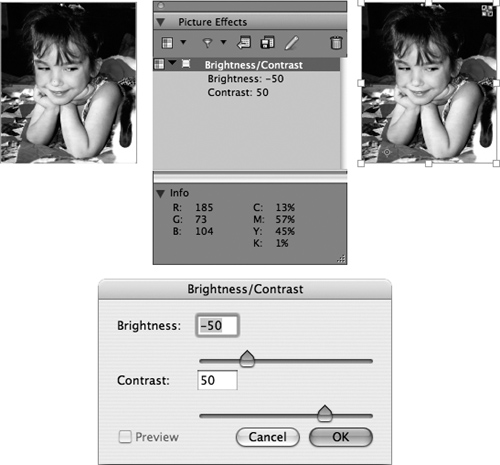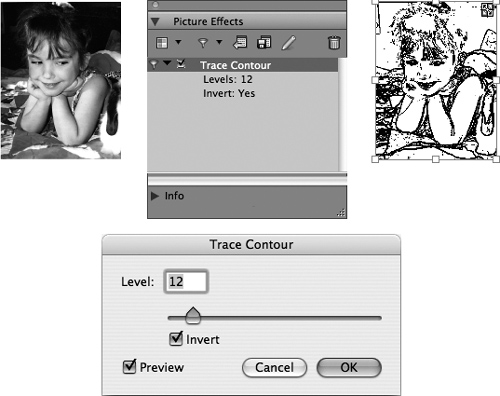Making adjustments
The 12 commands in the
Adjustments menu let you change the appearance of a picture by analyzing
and adjusting its pixels. For example, Brightness/Contrast lets you
make a picture lighter or darker, while Threshold lets you convert a
color image to black-and-white and specify the value threshold that
distinguishes black from white. You can apply as many different
adjustments—and filters—as you want to a single picture.
To make an adjustment to a selected bitmap picture:
1. | Choose an option from the Adjustments menu.
|
2. | Use
the controls in the dialog box that’s displayed to modify the
appearance of the picture. Each option offers a different set of
controls. Check the Preview box to display changes as you make them.
|
3. | When you’re done making changes, click OK. Figure 1 shows a before-and-after example of making an adjustment to a picture.
 |
Applying filters
The
12 commands in the Filters layer let you change the appearance of a
picture based on value differences within the picture. For example, the
Unsharp Mask filter increases the contrast where relatively light areas
meet relatively dark areas.
To apply a filter to a selected bitmap picture:
1. | Choose an option from the Filters menu.
|
2. | Use
the controls in the dialog box that’s displayed to modify the
appearance of the picture. Each option offers a different set of
controls. Check the Preview box to display changes as you make them.
|
3. | When you’re done making changes, click OK. Figure 2 shows a before-and-after example of applying a filter to a picture.

|
Each time you make an adjustment or apply a
filter to a picture, the effect is listed in the Picture Effects
palette. Click the check box to the left of an effect in the list to
alternately show and hide it. Click the small arrow to the left of the
check box to alternately show and hide the settings for the effect. A
small icon ( ) is displayed in the upper-right corner of pictures to which you’ve made an adjustment or applied a filter.
) is displayed in the upper-right corner of pictures to which you’ve made an adjustment or applied a filter.
To remove an adjustment or filter, select it from
the list in the Picture Effects palette, and then click the Delete
Effect icon at the top-right of the palette ( ).
).
Tip: Editing Picture Effects
To
modify an adjustment or a filter, double-click an applied effect in the
Picture Effects pane or select an effect, and then click the Edit
button ( ).
).